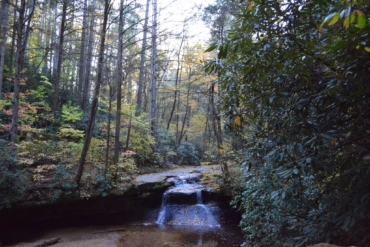The descent into a nondescript hole in the ground reveals an otherworldly setting carved by lava. Ice stalagmites, massive underground amphitheaters, and utter blackness occupy the exploration.

One of the nice things about living in a van with all your worldly possessions is that you never find yourself ill-equipped on a trip, thinking about the piece of gear you should have packed. So when I encountered the steep pile of unexpectedly icy boulders that I needed to descend to get to the floor of a massive lava tube, I was glad for the short walk back to retrieve my crampons.
I had been up since before sunrise, heading east out of Portland, stopping only to pick up a powerful new spotlight at a hardware store on the edge of town. Then it was into the gorge, which had thawed since my last visit, across the Bridge of the Gods into Washington, and north past a small herd of elk to Gifford Pinchot National Forest.

I slid around on paved forest service roads that were pied black and white with irregular shapes of slick ice and hard packed snow. I ran out of asphalt and continued north on grippier gravel and dirt, eventually wedging into a dead-end set of tracks near a remote trailhead.
I had a few notes describing the route to the entrance of the caves, an off-trail pit in the ground where the breakdown of a ceiling collapse exposed a passage to the floor of a deep underground tunnel. After exploring a few similar cave-ins with short dead-end passages, I found the one that I was looking for.

I only needed the crampons for a short section where the warmer humid cave air met the subfreezing conditions on the surface and left the rock pile at the entrance glazed in a thick layer of clear, wet ice. A garden of ice stalagmites grew like bulbous white fingers pointing up through the darkness.

Once inside, I stood in a massive chamber, 20 to 30 feet in width and 60 feet in height, with longitudinal striations on its walls suggesting the movement of the lava that once flowed down from Mount Adams to create this duct.

Further in, I passed a few bends in the cave and turned off my headlamp to experience total darkness. The air was still, cold, and damp. It was eerily quiet, save for the sporadic dripping of water on the cave floor.
The conditions brought to mind the set of a horror film. But instead I imagined the Spinal Tap fictional character Nigel Tufnel saying, “It’s like, how much more black could this be? The answer is none. None more black.”
I turned my lights back on and probed deeper into the cave. The walls were coated with thick bacterial slime. Just how long it took to form and how fragile it is to rebound from abuse was apparent by the ubiquitous “finger painted” names and dates left on the walls, many of which dated back to the 1970s and looked just as fresh as those of a more recent vintage.

I examined the crumbles of breakdown on the cave floor and found many rocks were polished smooth and black where they were exposed to the lava flow, and rough and brown on the other surfaces that were not.
Intersecting caves crossed the main chamber here and there and offered opportunities to scramble and climb to higher vantages. In one place, I found an abandoned fixed webbing ladder dangling from a ledge that led into a second-story tube.

I spent four hours underground and only explored a fraction of the cave, taking much time composing photos by the light of my two lamps before cutting my exploration short and returning to the surface, wary of getting stuck deep underground should my batteries die.
In short time I saw dim light stretching into the cave from around the last turn before the mouth, and I climbed back up to my van in the gray daylight, surrounded by pikas that I hadn’t noticed earlier in the day, chirping and darting back and forth among the fallen boulders.

—The Rubber Tramp Jeff Kish writes a weekly column on a laptop aboard the customized Ford Econoline in which he lives. You can catch up on Kish’s past stories: The Rubber Tramp Diary, Entry One, and his back story about shuttling through-hikers on the PCT.





